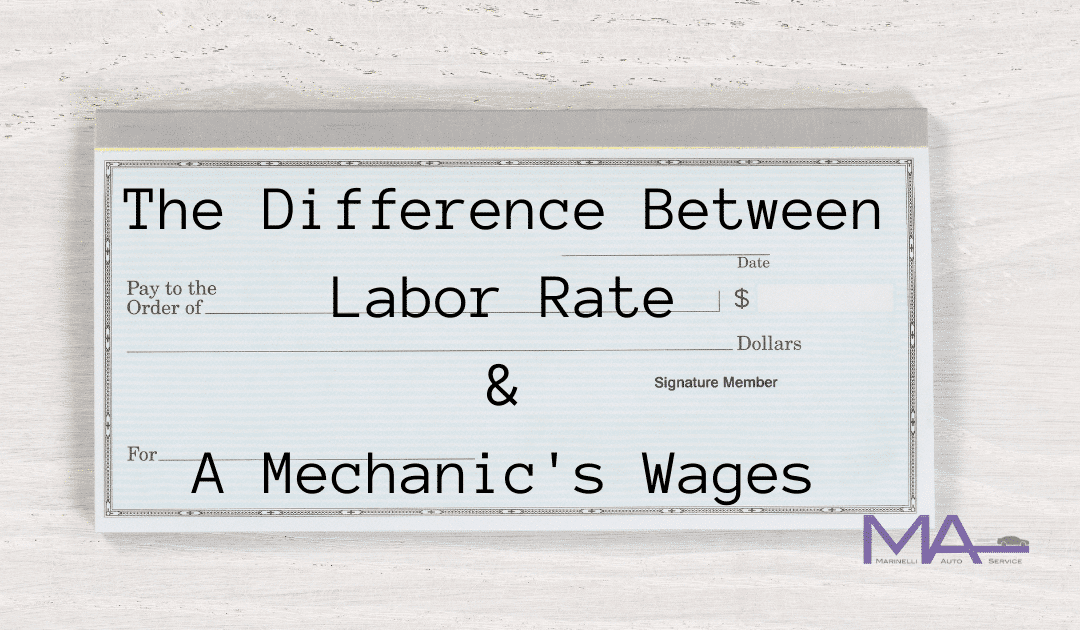I often see memes encouraging young people to consider trade school over college. It’s true that these tradesmen are needed and that a lot of them make good money. I usually comment, “Yes, a lot of these trades pay well, but auto repair doesn’t.”
“But my mechanic makes $60 an hour!” is the response.
“No, they don’t. Far less, actually.”
“So, why does my invoice say that the labor is $60/hour?” they retort.
Ah, the confusion. I’ve had conversations with many people with this misunderstanding. Let me clear it up for you. Labor rate and a mechanics wage are two different things.
What is Labor Rate?
When you receive your repair invoice there are two main components–parts and labor. The labor rate is how much per hour for each labor hour spent on your vehicle.
It’s important to know that the number of hours charged does not necessarily equate to the number of hours the mechanic spends on your vehicle. The vehicle manufacturer sets an amount of time it should take to do a procedure. This is called a flag hour. You will be charged based on this number (sometimes the shop will set it higher if the mechanic notes a complication–i.e. Rust–that will make the job take longer) even if the mechanic ends up taking longer to do the job. (This also affects the mechanics wage. More on this later.)
The labor rate will vary from shop to shop. A lower labor rate ($50 per hour) might mean there’s a higher parts markup (100% or more). A higher labor rate ($100 per hour) might mean that there’s a low parts markup (around 25%)–this is how we do our pricing. We believe that charging fairly for time is more transparent than hiking up the parts cost.
The labor rate covers the shop’s overhead, including the mechanic’s wages. The overhead includes the cost for keeping the shop open–utilities, tools and equipment, employee wages (not just the mechanic’s), subscriptions to informational resources, office supplies, marketing…the list goes on. The overhead for an auto repair shop is high compared to a lot of other businesses.
Auto Repair Terms
- Labor Rate–The amount per hour the shop charges for each labor hour spent on your vehicle
- Overhead–The amount of money it costs to run a business
- Flag Hour–The amount of time a vehicle manufacturer sets for a procedure
- Flat Rate–An hourly wage based on flag hours
- Parts Markup–The difference between the wholesale purchase price for a part and the shop’s selling price
How Much Does My Mechanic Make?
This is a surprisingly complicated question. There are two ways mechanics can be paid. One way is your typical hourly wage–if he works 40 hours a week he will make $xx per hour for 40 hours. This is uncommon. The more common way to pay a mechanic is by flat rate which depends on flag hours.
As we just discussed, a flag hour is based on how long the vehicle manufacturer says it should take to do a procedure. That means if the procedure is set to take an hour but the mechanic takes two, he will still be only paid for one hour. Less often, a procedure is set for one hour but the mechanic only takes thirty minutes, he still gets paid for an hour (this can be a red flag that the mechanic cut corners and didn’t do the job properly so that he can move on to the next job, thus making more money). This means that a mechanic might work a 40 hour work week but only get paid for 30 hours.
So how much does my mechanic actually make? This varies by shop and is usually based on experience. An inexperienced mechanic fresh out of trade school might start at $15 per flag hour whereas a highly experienced master mechanic might make as much as $40 per flag hour (this is highly uncommon). This means that if your mechanic is flagging 30 hours per week at $25 per flag hour, he is making about $36k per year. Does that surprise you?
Next time you get your bill for auto repair, I hope you have a better understanding of where your total comes from. The labor rate and parts markup covers the businesses overhead. A mechanic is only making on average $25 of the labor rate and parts markup profits. The total charges are based on the flag hour–how long the manufacturer says it should take to do the procedure.
If you want to know more about how your shop does things, I encourage you to ask your repair shop. It’s important to know where your money is going!
Marinelli Auto Service is an auto repair shop in Winter Park, Florida. We’ve been serving Central Florida since 2015. We provide maintenance and repairs for a variety of makes and models.
